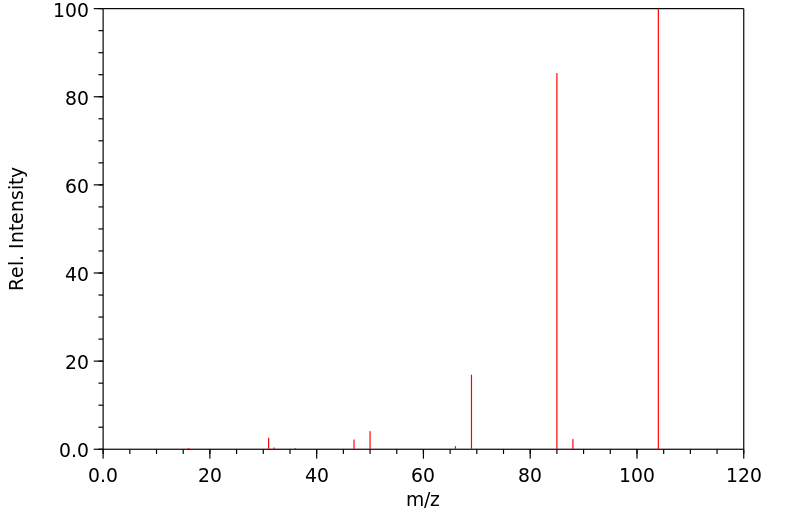磷酰氟 | 13478-20-1
中文名称
磷酰氟
中文别名
三氟氧化磷
英文名称
trifluorophosphoric acid
英文别名
phosphorus oxyfluoride;phosphorus oxytrifluoride;trifluorophosphorus oxide;Phosphoryl fluoride
CAS
13478-20-1
化学式
F3OP
mdl
——
分子量
103.968
InChiKey
FFUQCRZBKUBHQT-UHFFFAOYSA-N
BEILSTEIN
——
EINECS
——
-
物化性质
-
计算性质
-
ADMET
-
安全信息
-
SDS
-
制备方法与用途
-
上下游信息
-
文献信息
-
表征谱图
-
同类化合物
-
相关功能分类
-
相关结构分类
物化性质
-
熔点:-39.1℃ [KIR78]
-
沸点:-39,7°C
-
密度:4.562 g/L [LID94]
-
溶解度:与H2O反应
-
稳定性/保质期:
This is the content you provided.
计算性质
-
辛醇/水分配系数(LogP):1
-
重原子数:5
-
可旋转键数:0
-
环数:0.0
-
sp3杂化的碳原子比例:0.0
-
拓扑面积:17.1
-
氢给体数:0
-
氢受体数:4
安全信息
-
安全说明:S26,S36/37/39,S45,S7/9
-
危险类别码:R14,R34,R36/37/38
-
危险品运输编号:UN 3308
SDS
制备方法与用途
制备方法:
- 将POCl₃与3HF在双颈圆底烧瓶中反应生成POF₃和3HCl。
- 安装石英冷凝器,冷凝器上口连接至液态氧冷却的冷阱,冷阱出口接KF干燥管。
- 使用一根铁制毛细管穿过橡皮塞,深入到圆底烧瓶底部。
- 向烧瓶中加入POCl₃,并添加5%(质量)SbCl₅作为催化剂。
- 通过毛细管通入气态HF,保持反应温度在50~65℃之间。
- 冷阱中的产物(POF₃+3HCl)可经过多次分馏分离出来,收率约为90%(按POCl₃计)。
合成制备方法:
- 将POCl₃与3HF反应生成POF₃和3HCl。
- 安装石英冷凝器,冷凝器上口连接至液态氧冷却的冷阱,冷阱出口接KF干燥管。
- 使用一根铁制毛细管穿过橡皮塞,深入到圆底烧瓶底部。
- 向烧瓶中加入POCl₃,并添加5%(质量)SbCl₅作为催化剂。
- 通过毛细管通入气态HF,保持反应温度在50~65℃之间。
- 冷阱中的产物(POF₃+3HCl)可经过多次分馏分离出来,收率约为90%(按POCl₃计)。
反应信息
-
作为反应物:参考文献:名称:Phosphorus-Halogen Compounds from Phosphorus Pentoxide and Halides. Properties of Phosphorus Trifluoride and Phosphorus Oxyfluoride*摘要:DOI:10.1021/ja01852a002
-
作为产物:参考文献:名称:Moissan, H., 1886, vol. 103, p. 1257 - 1260摘要:DOI:
-
作为试剂:描述:参考文献:名称:Notes. Organophosphorus Compounds. V. Dialkyl Phosphorofluroidates摘要:DOI:10.1021/jo01092a604
文献信息
-
Preparation and properties of difluorophosphino(tetrafluorophosphoranyl)amine作者:David W. H. Rankin、John G. WrightDOI:10.1039/dt9790001070日期:——The compound NH(PF2)(PF4) has been prepared from PF2[NH(SiH3)] by reaction with PF5. Vibrational, photoelectron, n.m.r., and mass spectroscopic data have been recorded, and interpreted in terms of the probable structure and conformation of the molecule. At low temperatures the phosphorus(V) group has chemically equivalent equatorial fluorine atoms but non-equivalent axial atoms, indicating restricted
-
Chlor(trifluorphosphan)gold(I): [Au(PF3)Cl]作者:Frauke Schödel、Michael Bolte、Matthias Wagner、Hans-Wolfram LernerDOI:10.1002/zaac.200500453日期:2006.3Chloro(trifluorophosphane)gold(I): [Au(PF3)Cl] X-ray quality crystals of [Au(PF3)Cl] (orthorhombic, Pnma) are obtained from a toluene / pentane solution at 6 °C. According to the result of the X-ray structural analysis, [Au(PF3)Cl] contains an almost linear F3P-Au-Cl unit. The shortest Au-Au contacts between two of these units are 3.3495(9) A.
-
Some Reactions of Peroxydisulfuryl Difluoride作者:Jean'ne M. Shreeve、George H. CadyDOI:10.1021/ja01483a007日期:1961.11Abstract : The reactions of peroxydisulfuryl difluoride with several substances have been examined. Three new fluorosulfonates, octafluorobis(fluorosulfonato) cyclopentane (C5F8(SO3F)2), tetrafluorobis(fluorosulfonato)ethane (C2F4(SO3F)2) , and tetrafluorobis(fluorosulfonato)sulfur (VI) (SF4(SO3F)2) were produced by direct combination of peroxydisulfuryl difluoride with perfluorocyclopentene (C5F8)
-
Matrix Isolation and Theoretical Study of the Reaction of Substituted Phosphines with CrCl<sub>2</sub>O<sub>2</sub>作者:Adam J. Delson、Bruce S. AultDOI:10.1021/jp066215y日期:2006.12.1The reactions between CrO2Cl2 and a series of substituted phosphines have been investigated using matrix isolation infrared spectroscopy. For all of the phosphines except PF3, twin jet co-deposition of the two reagents into argon matrices at 14 K initially led to the formation of weak bands due to the corresponding phosphine oxide. For all of the phosphines, subsequent irradiation with light of lambda
-
Synthesis of Metal Phosphates Using SiP2O7作者:Carlos E. Bamberger、George M. Begun、Dale E. HeatherlyDOI:10.1111/j.1151-2916.1983.tb10575.x日期:1983.11The reaction of SiP/sub 2/O/sub 7/ with rare-earth fluorides and oxides and with UO/sub 2/ proceeds at high temperatures (1000/sup 0/ to 1200/sup 0/C) to convert the rare-earth and uranium compounds to ortho- or pyro-phosphates. In these reactions between intimately mixed powders, very finely segregated SiO/sub 2/ is formed and distributed throughout the phosphates. This procedure may be useful for
表征谱图
-
氢谱1HNMR
-
质谱MS
-
碳谱13CNMR
-
红外IR
-
拉曼Raman
-
峰位数据
-
峰位匹配
-
表征信息
同类化合物
高碘酸
氟化氘
过氯酰氟
过氧二硫酰氯
肼二氢溴酸盐
肼二氟化物
联氨-d4氯化氘
联氨-15N2二盐酸盐
羟铵氟化物
羟胺二氢氟酸盐
羟基胺氢碘酸盐
磺酰氯
磷酰胺叠氮化亚胺氯化(9CI)
磷酰氟
碘叠氮化物
碘化氮
碘化氢(~121~I)
碘化氘
碘123
硫酰碘
硫酰氟
硫光气
硝酰氟
硝基溴
盐酸肼
盐酸羟胺-D3
盐酸羟胺-15N
盐酸羟胺
盐酸
焦硫酰氟
溴叠氮化物
溴化铵-15N
溴化氧硒
溴化氢(~80~Br)
溴化氢(~75~Br)
溴化氘
氯磺酸
氯磷酰腈
氯氧基氟化物
氯氟磺酰
氯叠氮化物
氯化铵-d4
氯化硫杂氮
氯化硫
氯化氮
氯化亚砜
氯化二硫酰
氯二氟氧膦
氨磺酰碘化(9CI)
氨基磺酰氯







